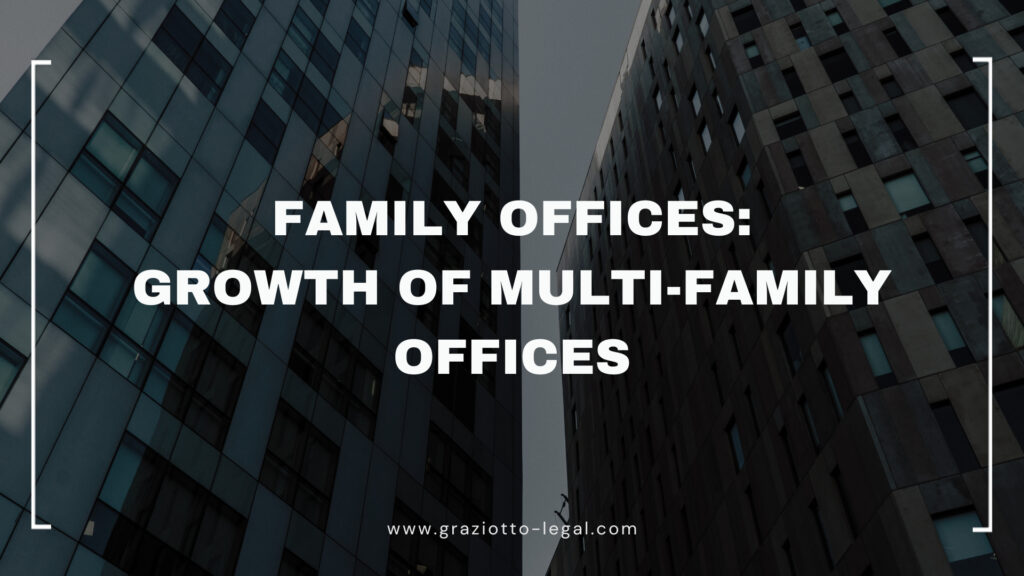

Since 2010, the Global Law Experts annual awards have been celebrating excellence, innovation and performance across the legal communities from around the world.
posted 4 weeks ago
The growth of Multi-Family Offices (MFOs) represents one of the most significant trends in the family office landscape. MFOs offer a shared platform where multiple families can access a broad array of services.
This structure has become increasingly appealing for many reasons, and its development has been influenced by various factors. Here, we explore the rise of MFOs, diving into the underlying causes, the evolution of services, the benefits and challenges, and the impact on the industry.
– Historical Context: The concept of a multi-family office has its roots in the traditional single-family office but adapted to cater to the needs of multiple families. This idea emerged as the complexities of managing wealth became more apparent, and families sought efficient ways to access expert services.
– Democratization of Services: By sharing costs across several families, MFOs democratized access to family office services, making them available to a broader wealth spectrum.
– Economies of Scale: The shared platform allows for cost savings in operations, technology, and professional fees.
– Diversification of Expertise: MFOs can attract top-tier experts in various fields, offering families access to a wider range of specialized services.
– Globalization of Wealth: With the spread of wealth across different regions and the internationalization of families, MFOs provide a solution for cross-border services and compliance.
– Regulatory Challenges: The ever-changing regulatory landscape has led many families to prefer the MFO model to navigate complex compliance requirements.
– Investment Management: MFOs have brought innovative investment strategies, blending traditional and alternative investments, offering tailored solutions for different risk appetites.
– Consolidated Reporting: With multiple investments and assets spread across various locations, MFOs have developed comprehensive reporting systems, enabling families to have a consolidated view of their financial position.
– Philanthropy Coordination: Many MFOs have specialized in aligning philanthropic goals with investment strategies, helping families achieve their social impact objectives.
– Education and Networking: MFOs often facilitate educational workshops and networking opportunities among families, fostering collaboration, and shared learning experiences.
– Accessibility: MFOs have opened the door to family office services for families who may not have the resources to establish a Single Family Office (SFO).
– Expertise and Innovation: Access to a diverse team of experts encourages innovative solutions and robust service offerings.
– Collaborative Environment: Sharing experiences and goals among families has fostered a collaborative environment, enhancing decision-making processes.
– Confidentiality Concerns: Ensuring privacy and security of sensitive information in a shared environment has been a concern for some families.
– Potential Conflicts of Interest: Managing multiple families might lead to conflicts, especially if the families have competing interests or opposing investment philosophies.
– Customization vs. Standardization: Striking the right balance between providing tailored services and maintaining standardized processes has been an operational challenge for many MFOs.
– Industry Fragmentation: The rise of MFOs has led to a fragmented landscape, with numerous players offering varying degrees of services and specialization.
– Collaboration with Other Professionals: MFOs often work closely with other professionals such as legal and tax advisors, leading to an integrated ecosystem around family wealth management.
– Technology Adoption: The competitive environment has pushed MFOs to adopt advanced technology to improve efficiency and client experience.
– Regulatory Scrutiny: With the growth of MFOs, regulatory bodies have increased their scrutiny, leading to new compliance and reporting requirements.
– Continued Growth: The MFO model is expected to continue growing, driven by increasing wealth complexity and globalization.
– Enhanced Customization: The trend towards personalized and client-centric services is likely to shape the future development of MFOs.
– Integration with Social Values: As families become more conscious of social and environmental impacts, MFOs are likely to evolve to integrate these values into their services.
The growth of Multi-Family Offices marks a significant milestone in the family office industry. The MFO model has democratized access to family office services, provided economies of scale, and fostered innovation.
However, it has also brought new challenges, such as maintaining confidentiality and managing potential conflicts.
The rise of MFOs reflects the evolving needs and complexity of modern family wealth, providing a flexible and collaborative platform for wealth management. This trend is set to continue, shaping the future landscape of the family office industry.
For more in-depth information you can consult my latest book «The Global Manual for Family Offices», Volume 1, Chapter 4.1.3, Pg. 243.
Author


No results available
Resetposted 2 days ago
posted 3 days ago
posted 3 days ago
posted 6 days ago
posted 7 days ago
posted 1 week ago
posted 1 week ago
No results available
ResetSign up for the latest advisory briefings and news within Global Advisory Experts’ community, as well as a whole host of features, editorial and conference updates direct to your email inbox.
Naturally you can unsubscribe at any time.
Global Advisory Experts is dedicated to providing exceptional advisory services to clients around the world. With a vast network of highly skilled and experienced advisers, we are committed to delivering innovative and tailored solutions to meet the diverse needs of our clients in various jurisdictions.